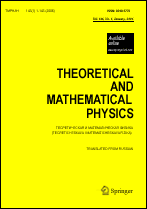|
This article is cited in 2 scientific papers (total in 2 papers)
Field theory and anisotropy of a cubic ferromagnet near the Curie point
A. Kudlisab, A. I. Sokolova
a Saint Petersburg State University, St. Petersburg, Staryi
Petergof, Russia
b St. Petersburg State University of Information Technologies, Mechanics and Optics, St. Petersburg, Russia
Abstract:
It is known that critical fluctuations can change the effective anisotropy of a cubic ferromagnet near the Curie point. If the crystal undergoes a phase transition into the orthorhombic phase and the initial anisotropy is not too strong, then the effective anisotropy acquires the universal value $A^*=v^*/u^*$ at $T_{\mathrm c}$, where $u^*$ and $v^*$ are the coordinates of the cubic fixed point of the renormalization group equations in the scaling equation of state and expressions for nonlinear susceptibilities. Using the pseudo-$\epsilon$-expansion method, we find the numerical value of the anisotropy parameter $A$ at the critical point. Padé resummation of the six-loop pseudo-$\epsilon$-expansions for $u^*$, $v^*$, and $A^*$ leads to the estimate $A^*=0.13\pm0.01$, giving evidence that observation of anisotropic critical behavior of cubic ferromagnets in physical and computer experiments is entirely possible.
Keywords:
cubic model, effective anisotropy, renormalization group, $\epsilon$-expansion, pseudo-$\epsilon$-expansion.
Received: 09.12.2015
Revised: 09.04.2016
Citation:
A. Kudlis, A. I. Sokolov, “Field theory and anisotropy of a cubic ferromagnet near the Curie point”, TMF, 190:2 (2017), 344–353; Theoret. and Math. Phys., 190:2 (2017), 295–302
Linking options:
https://www.mathnet.ru/eng/tmf9112https://doi.org/10.4213/tmf9112 https://www.mathnet.ru/eng/tmf/v190/i2/p344
|


| Statistics & downloads: |
| Abstract page: | 365 | | Full-text PDF : | 149 | | References: | 39 | | First page: | 16 |
|




 Contact us:
Contact us: Terms of Use
Terms of Use
 Registration to the website
Registration to the website Logotypes
Logotypes








 Citation in format
Citation in format 
